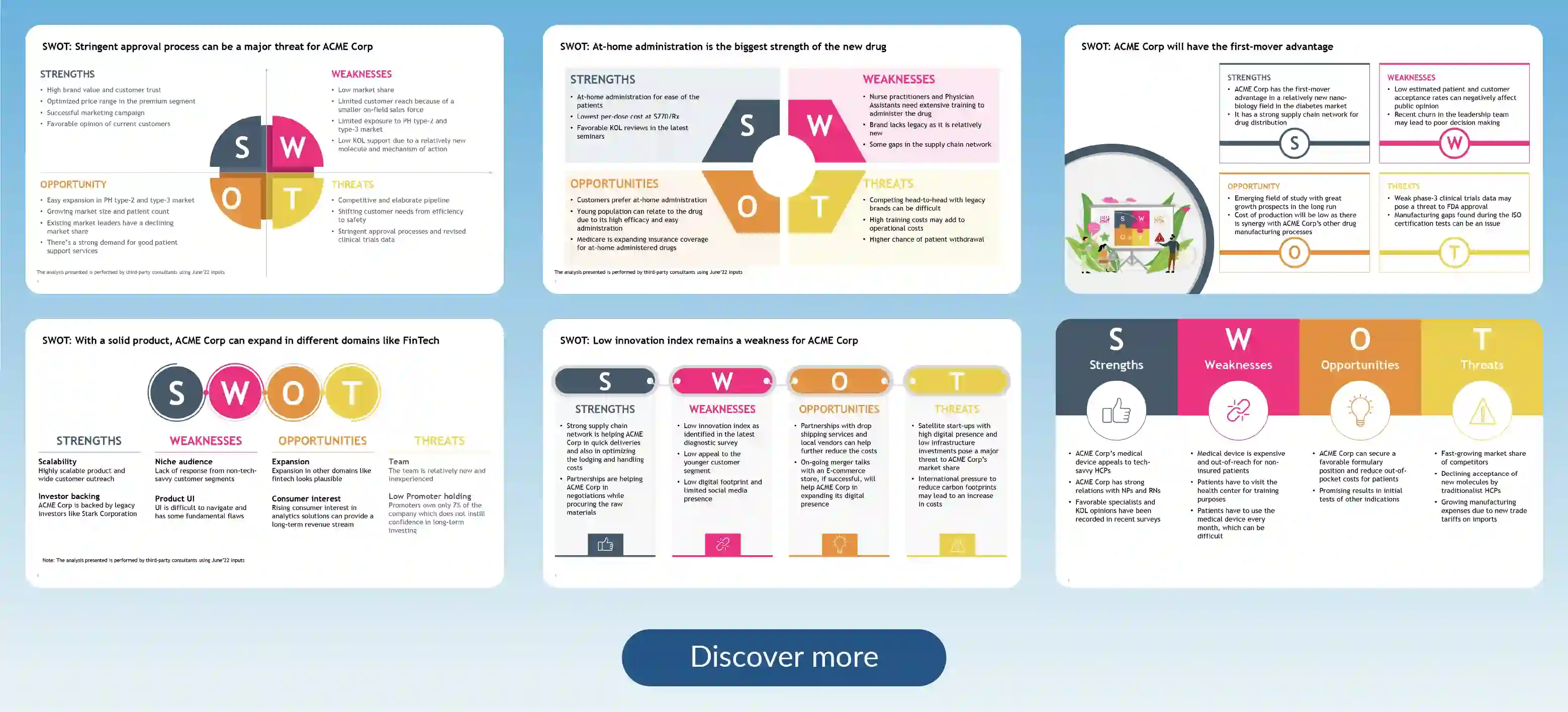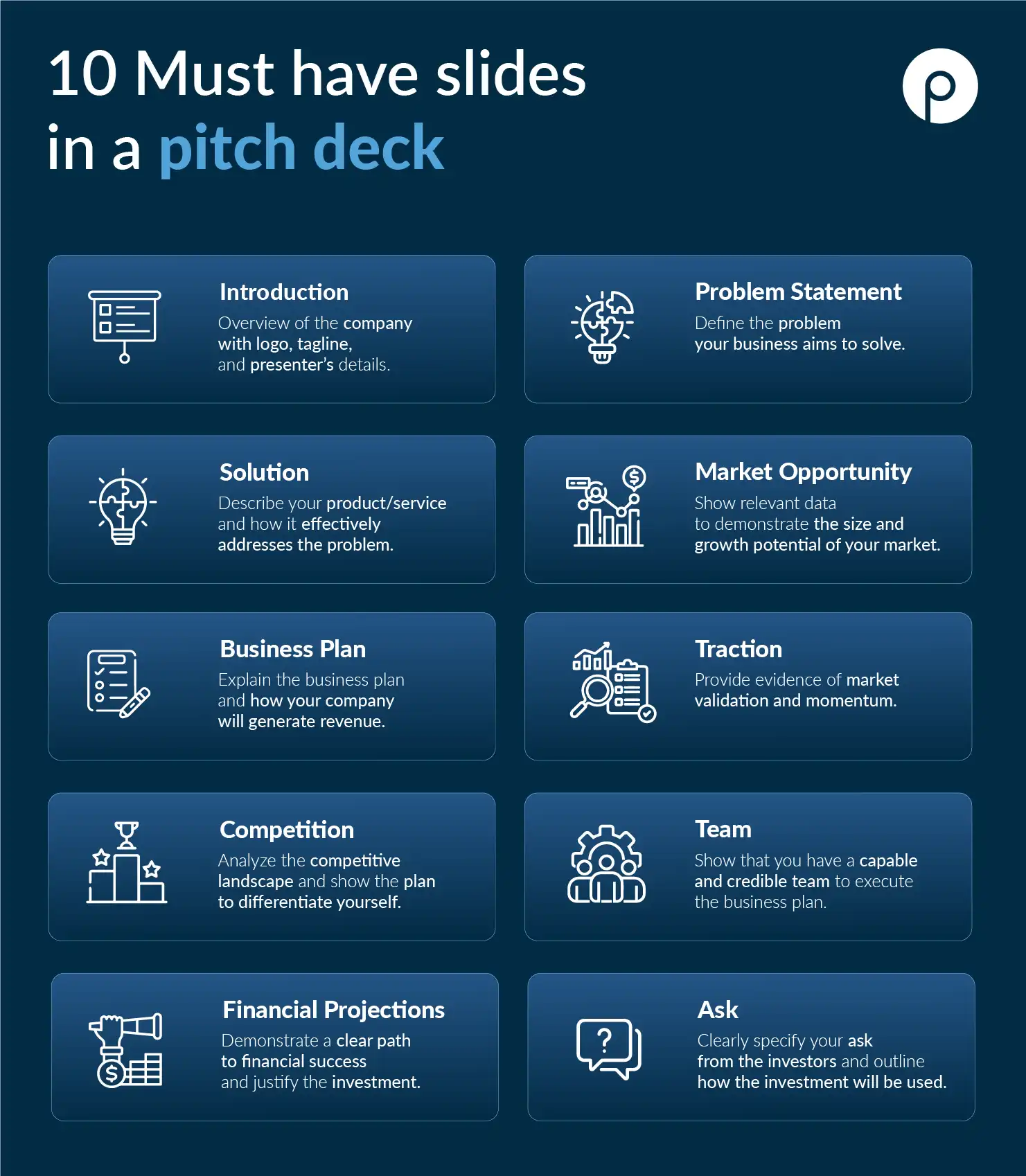What is a pitch deck: A guide for entrepreneurs with expert tips and template example

Pitch decks are dearly close to entrepreneurs as they are the tools that add fuel to their dreams, providing the reassurance and confidence they need. However, pitch decks can be very tricky. Research by Harvard Business School shows that startup founders spend an average of 18 hours refining their pitch decks. Imagine the amount of work that goes into building, refining, and updating these crucial presentations.
If you are about to create a pitch deck or are thinking of refining your existing deck, this article will provide you with the guidance you need. We will explore the essentials of a pitch deck and share tips to help you create an exceptional presentation that investors will remember.
What is a pitch deck?
A pitch deck is a set of visually appealing slides designed to provide comprehensive information about a company or venture. Its primary purpose is to persuade a specific audience, typically potential investors, of the viability and potential success of the business.
A pitch deck is crucial for entrepreneurs and startup founders seeking to secure investment. It is visually appealing, concise, and informative, and it can effectively communicate a business's value and potential to potential investors.
However, it is not as simple as it sounds. Just compiling a set of visually appealing slides will not guarantee success in securing funds. Pitch deck presentations are much more than just attractive slides and a good business idea. Even the best business ideas have failed to secure funds due to less compelling pitch decks.
Let us start with the key information and see how to perfect your pitch deck for the funding round.
How many slides should be included in a pitch deck?
The 10/20/30 rule of PowerPoint, invented by renowned venture capitalist and speaker Guy Kawasaki, is highly applicable to pitch deck presentations. This rule suggests including only 10 slides in a presentation, which should be covered in 20 minutes and should use no fonts smaller than 30 points.
Guy Kawasaki advocates for this rule to ensure that presentations are concise and engaging, covering all essential details required to interest investors without overwhelming them with excessive information. The objective is to generate enough interest to secure a second meeting.
10 must-have slides of a pitch deck:
Introduction:
The introduction slide is like the cover page of your book. Make a strong first impression with this slide. It should contain your company name, logo, topics you cover, and your (presenter’s) details. Your purpose should be effectively communicated on this slide, giving the audience a clear idea of what you are going to discuss and why it matters.
💡 Tips: Keep it clean and professional. Ensure the tagline is relevant and clearly reflects your business's mission and vision.
Problem statement:
Clearly define the problem your business aims to solve. The problem statement slide helps investors understand the significance and relevance of the issue. Once they empathize with the problem, they will be more inclined to support the solution.
💡 Tips: Use relatable examples or statistics to emphasize the problem's impact. Make sure it resonates with your audience. Emphasize the consequences of the unsolved problem and show why it’s critical to address this issue now.
Solution:
Your solution slide describes your product or service and how it effectively addresses the problem. Its purpose is to showcase how your solution stands out and meets the needs of your target market.
💡 Tips: Clearly explain the product's unique features and benefits over available alternatives in the market. Share testimonials or case studies that demonstrate the real-world impact of your solution. If possible, include a live demo to provide a tangible experience.
Market opportunity:
The market opportunity slide explains the scope or potential of the market you are going to capture. It provides your audience with a clear view of your position compared to the existing competition in the market. Talk about market size, growth, trends, and your target market segment.
💡 Tips: Use data from reliable sources to substantiate your claims about market size and growth. You can conduct customer surveys and studies to provide substantial figures and proof. Explain why now the right time is to enter the market by highlighting trends or changes that make your solution particularly relevant.
Business model:
This slide explains how your company will generate revenue and become profitable. Include details on revenue streams, pricing strategy, and sales channels to provide a clear understanding of your business model. The purpose of the business model slide is to convince investors that your business model is sustainable and scalable.
💡 Tips: Present your business model in a straightforward manner. Use flowcharts or diagrams to represent how your business operates visually. This can help simplify and clarify complex models. Talk about your pricing strategy and sales channels and explain the reasons behind those decisions.
Traction:
The traction slide showcases the milestones your company has achieved so far. Traction provides evidence of market validation and momentum, demonstrating that your business is progressing and gaining interest.
💡 Tips: Present data clearly and compellingly using graphs and charts. Visual representations of growth can be more impactful than numbers alone. Show important metrics such as user growth, sales figures, customer acquisition, and retention rates.
Competition:
Talk about your main competitors and analyze their strengths and weaknesses. A detailed SWOT analysis will help you identify and highlight your competitive advantage. This analysis will also assist you in planning how to differentiate yourself in the market.
💡 Tips: Be honest about your competitors. Investors appreciate a realistic and well-thought-out assessment. Present the SWOT analysis table to give a comprehensive view of your position in the market. This will help the audience understand your position compared to that of your competitors.
Below is a 100% customizable SWOT analysis slide template that will help you effectively communicate the market's strengths, weaknesses, opportunities, and threats.

Team:
Introduce the key members of your team and their relevant experience. This slide is important as the investors would like to know the skill sets and experience of the people invested in the venture. The team slide aims to show that you have a capable and credible team to execute the business plan.
💡 Tips: Provide brief bios highlighting each team member's background, skills, and accomplishments. Emphasize the experience that is particularly relevant to your business and industry.
Financial projections:
Present your financial projections for the next 3-5 years, including key metrics such as revenue, expenses, and profitability. This slide should demonstrate a clear path to profitability and justify the investment you propose.
💡 Tips: It is advisable to use realistic assumptions and be prepared to explain the numbers. Investors will want to know how you arrived at your numbers. Make use of charts and tables to make the data more digestible. It is important to ensure that your projections are realistic and achievable.
Ask:
The ask slide is where you provide a clear call to action and make it easy for investors to understand their role and the potential return on investment. Specify what you are asking for from the investors, whether it's funding, partnerships, or other types of support. Also, outline how the investment will be used. Investors need to see that their money will be used effectively to drive growth and success.
💡 Tips: Clearly state the exact amount of funding you are seeking. Provide a detailed allocation of the funds, such as how much will be used for product development, marketing, hiring key team members, and covering operational expenses. Highlight the potential return on investment (ROI) for the investors, explaining the benefits they will gain from supporting your venture.

What makes a good pitch deck presentation?
On average, around 1,000 pitch decks are created every day worldwide, but only 1% of them secure funding. That means your pitch deck must stand out from the rest to be unforgettable. Here are a few tips that will help you:
Visual Design and Layout: A professional, clean design with consistent branding, clear headings, and high-quality visuals enhances the overall presentation. Visual aids like infographics, charts, and images help convey complex information in an accessible and engaging manner. Studies show that pitch decks with visuals are 43% more persuasive than text alone. Ensuring that your pitch deck is visually impressive provides numerous benefits:
- Information is 70% more memorable with visual elements.
- Visuals produce 22% higher results in 13% less time.
- Use of visual elements also reduces meeting durations by 24%.
Concise information: An effective pitch deck is concise, usually consisting of 10 to 12 slides. This ensures that the information is digestible and keeps the audience's attention throughout the presentation.
Storytelling: Instead of just presenting logic and numbers, engage the audience with a compelling narrative that keeps them attentive and helps you connect emotionally to the cause. When investors find the story relatable, they will remember your pitch. A good narrative helps investors envision your goal and understand how customers will benefit from your product or service. Storytelling proves to be a powerful tool for enhancing information retention and improving conversion rates.
Less is more: Avoid the temptation of overloading the deck with too much information. Respect the time of potential investors and understand that humans have a limited attention span. Be clear and straightforward in your presentation using bullets, infographics, and other data visualization techniques. Focus on including the most critical information in the most effective way without overwhelming the audience.
Logical flow: Research shows that the order of slides can impact the effectiveness of a pitch deck. The most effective decks typically follow a logical flow, starting with the problem, followed by the solution, market opportunity, business model, traction, and competition, and ending with the team and financials.
Update your deck: You will pitch to various potential investors at different times. Make sure that each time you present your pitch deck, it is updated with the latest information, metrics, trends, and milestones achieved. This showcases your preparedness and professionalism, also improving your credibility.
What are the key slides investors focus on?
According to a study conducted by Harvard Business School, investors spend an average of only 3 minutes and 44 seconds reviewing a pitch deck. This limited time frame underscores the importance of making a strong first impression and ensuring your pitch deck is visually compelling, concise, and easy to follow. To maximize this brief window of opportunity, it’s crucial to understand which slides capture the most attention and how to make them effective.
Financials
The financials slide gains the most attention from investors, with an average viewing time of 23 seconds per slide. This slide demonstrates due diligence and a well-thought-out plan. Financial projections should cover at least the next 3-5 years and include revenue forecasts, expenses, profit margins, and key metrics. It's important to balance detail with clarity, ensuring projections are realistic and supported by data.
Interestingly, many startups, even some successful ones, often lack detailed financial information in their pitch decks. So, how do they still secure investments? The key lies in the financial narrative. Even if you don’t have extensive financial details, you can still succeed by presenting a well-articulated forecast that shows you have done your homework and have a clear roadmap for growth.
💡 Tips:
- Include realistic financial projections for the next 3-5 years.
- Highlight key metrics such as revenue, expenses, profit margins, and customer acquisition costs.
- Use visuals like graphs and charts to make complex data more accessible.
Team
The team slide is the second most viewed, emphasizing the importance of having a strong and credible team. Investors invest in people as much as in ideas; they want to see that your team has the skills, experience, and passion needed to execute the business plan successfully.
💡 Tips:
- Highlight the relevant experience and expertise of each key team member.
- Include any notable advisors or board members who add credibility to your venture.
- Showcase the team's ability to work well together and adapt to challenges.
Market opportunity:
This slide is one of the top considerations for investors. It provides insight into your business's potential growth by detailing the size and scope of the market you are targeting. A thorough market opportunity analysis can instill confidence in investors about your company's future prospects.
💡 Tips:
- Define your total addressable market, serviceable available market, and serviceable obtainable market.
- Use data and statistics to back up your claims about market size and growth potential.
- Highlight trends and market dynamics that favor your business.
Business plan:
This slide is highly scrutinized because investors want to understand how your company plans to generate revenue. A clear and sustainable business model is critical for convincing investors that your business can achieve profitability.
💡 Tips:
- Explain your revenue streams and pricing strategy.
- Detail your sales and distribution channels.
- Highlight any existing partnerships or customers that validate your business plan.
In the short span of time that investors spend on a pitch deck, it is crucial to make every second count. Focus on the financials, team, and market opportunity slides, as these are the most scrutinized. A strong financial narrative can make a significant difference even if you lack detailed financial data. Emphasize the strength of your team and provide a clear, compelling business plan.
Investors will have many questions about your venture. Your pitch deck plays a crucial role in your success and should be able to answer most of these questions. Refer to the article below to explore the various questions your pitch deck should address.
Article: How to craft an effective pitch deck presentation?
Frequently asked question about pitch deck
1. What types of pitch decks are most effective for different stages of a startup?
Different stages of a startup may require various types of pitch decks. For instance, a seed pitch deck focuses on the initial vision and potential market, while a growth stage pitch deck emphasizes financials and scaling strategies.
2. How can an investor deck captivate the audience in a limited time?
An investor deck should be concise, visually engaging, and narrative-driven. Using compelling visuals, a clear storyline, and data-backed insights can effectively captivate investors and increase engagement.
3. What are the common mistakes to avoid in a pitch presentation?
Avoiding overly complex slides, lack of clarity, and excessive text is crucial. A powerful pitch deck should highlight the core aspects of the business and present a clear and compelling case for investment.
4. How should a pitch deck outline the use of funds to get investors interested?
The use of funds slide should be specific and transparent, detailing how the investment will be allocated across various business areas, such as product development, marketing, or team expansion, to grow your business.
5. What makes a pitch deck successful for raising funds from investors?
A successful pitch deck is a brief presentation that clearly communicates the business model, market opportunity, and financial projections, while also showcasing a strong team, a compelling problem-solution narrative, and a clear return on investment.
How can Prezent AI help to build an impressive pitch deck?
Creating a great pitch deck takes considerable time and effort. Top priorities are ensuring the deck is aesthetically refined, consistent with brand elements, tells the right data story, and has a compelling storyline. Prezent AI can help streamline this process and create a polished pitch deck in 50% less time. Here’s how:
Visual design and layout
Design and layout significantly impact readability and engagement. Pitch decks with high-quality visuals and professional design are 30% more likely to capture investor interest. Prezent AI’s Slide Library feature offers over 35,000 slide options for various scenarios. Complex information becomes more digestible with clear infographics, charts, and images. Prezent AI ensures 100% brand consistency, providing a clean, professional design with high-quality visuals that enhance the effectiveness of your pitch deck.
Storyline
Research shows that the human brain is 22 times more likely to retain information when presented in the form of stories. However, knitting a story with your business model and data can be challenging. Prezent AI’s Story Builder feature offers over 1,000 pre-designed, professionally curated storylines for various business scenarios, helping you create a compelling narrative.
Brand compliance and personalization
Ensuring consistency across all slides is challenging. Ensuring branding and personalization for different investors can be time-consuming, even with a ready presentation. Prezent AI’s Template Converter and Fingerprint features address these challenges. The Template Converter makes your presentation 100% brand-compliant in just a few minutes, saving you numerous stressful hours. The Communication Fingerprint feature helps hyper-personalize content according to your audience, ensuring your pitch resonates with each investor.
By leveraging Prezent AI’s capabilities, you can create an impressive pitch deck efficiently. Our pitch deck software offers many powerful features that can significantly boost your presentation efficiency, saving you ample time that you can invest in perfecting your delivery or tackling your long to-do list.
Explore the powerful features of Prezent AI by scheduling a demo with our experts. You can also explore the platform yourself with a free trial.
.avif)











